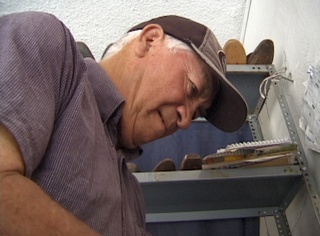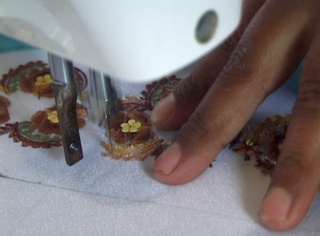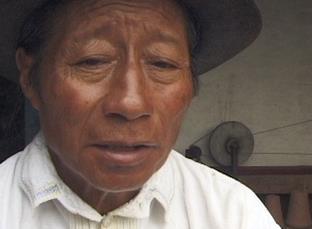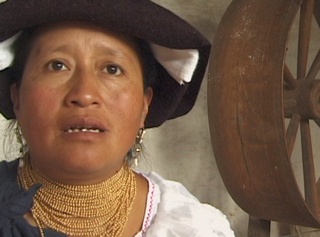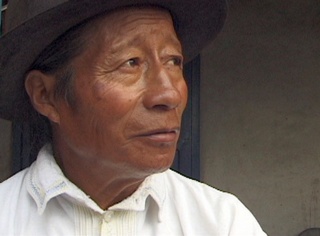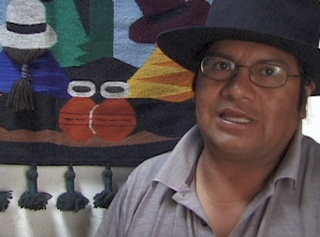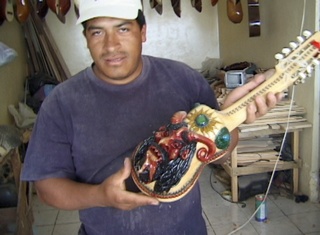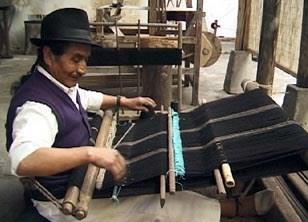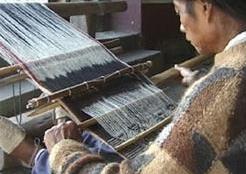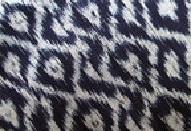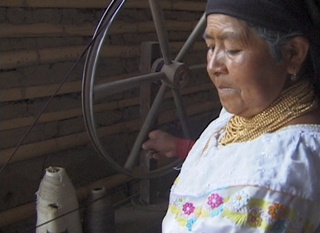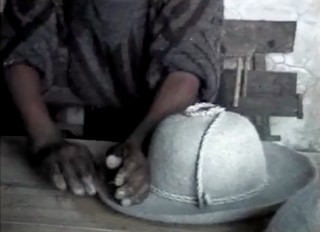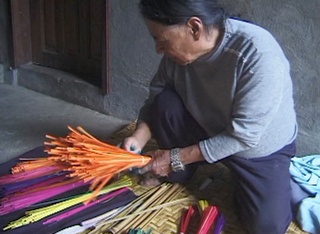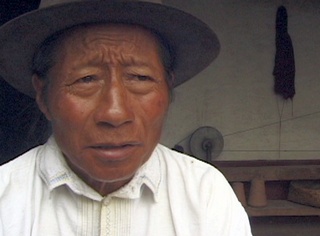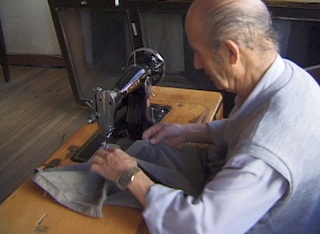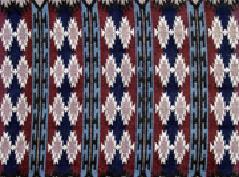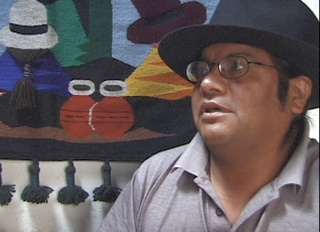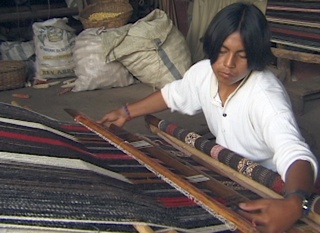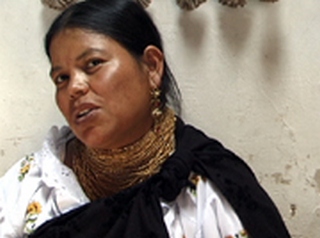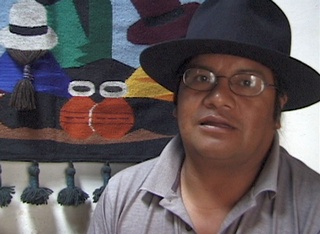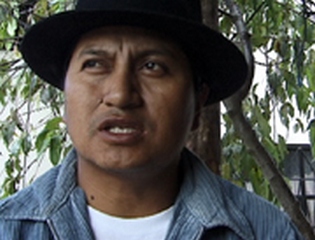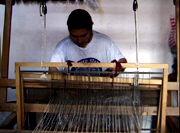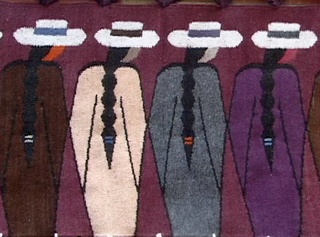Now one of the most renowned weavers of Ecuador, Tio José Cotacachi recounts his childhood experiences and the "business" of weaving back in the 60's before tourism changed the business of the weaving community forever.
Miguel Andrango is Ecuador’s most famous weaver! Miguel has dedicated his life to the art of weaving and the traditions of rural agriculture. He is a man of “bastante paciencia”, a quality necessary to survive as a weaver in today’s world.
Ecuador’s most famous weaver, Miguel Andrango offers us his vast knowledge and demonstrations. He still works on a backstrap loom, the weaving tool that predates the Incas. Carefully preparing all by hand, tio Miguel has spent a lifetime reinforcing his culture.
Making hats for over 60 years, Taita Marco is a true master and the last of his kind. The wide brimmed hats used by the Otavalo campesinos were replaced with factory made fedoras many years ago but Taita Marco continued to find a market for his work.
Otavalo is a center of Andean folklore music. The charango, similar to a mandolin, must be handmade with precision. I ran into Rafael Saltos and his wife today and they allowed me to film them in their workshop a couple of blocks from the plaza.
Taita Luis Maldonado and his wife have owned and operated the “El Obraje” museum for over 7 years. They guide us through the details of the weaving process from cleaning the raw wool to carding to spinning to weaving to the final preparations.
Maestro Rafael Saltos, Instrument Maker
The Weavers of Otavalo
The Weavers of Otavalo
The Weavers of Otavalo
The Weavers of Otavalo
The ancient weaving technique of Ikat was common throughout the Andes. I made this video a while ago for the Otavalo Anthropological Institute. A workshop was financed to reestablish and reenforce old methods of producing bolts of material with Ikat patterns .
Paradero Inca Tambo, Weavers of Peguche
Ikat Weaving in Otavalo
Miguel Andrango, Master Weaver
El Obraje, Otavalo’s best Museum
Taita Marco, Hatmaker of Illuman
Few weavers continue to earn a living working at their craft. The earnings are just not high enough or quick enough to attract young people. Luzmilla Andrango, daughter of Taita Miguel Andrango, speaks of the need to preserve the ancient technique.
Taita Miguel Andrango speaks of the evolution of the textile industry here in Otavalo. Looms that had been used for forced labor on the haciendas were later used to make cashmires for whites in Quito. Soon the Otavalos began to travel and offer other products abroad.
Susana Perugachi, Machine Embroidery
The typical blouse of the Otavalo Indigenous women is embroidered, usually by machine. Susana Perugachi is a master at her trade. She works at home producing embroidered blouses which she sells to two stores in Otavalo.
Manuel Rodrigo Cadenas, Boot Maker of Otavalo
For 57 years maestro Manuel Rodrigo Cadena has made shoes and boots for both foreigners and Otavaleños. He is the last of his kind in Otavalo and perhaps the last of his kind in the province. Custom made quality leather boots are his specialty!
All otavalovideos.com videos are owned and copyrighted 2019 by Frank M. Kiefer. Reproduction is prohibited. All rights reserved.
If you have any questions please write to videos@otavalovideos.com
If you have any questions please write to videos@otavalovideos.com
Taita Gavilano Oyagato, Basket Weaver
Less than 50 years ago, the village of Punyaro was dedicated to the production of Baskets with a market that extended throughout Ecuador. Today, only one individual still practices the trade, Taita Gavilano Oyagato. Visit his workshop with us.

OTAVALOVIDEOS.COM Artisans of Otavalo













Segundo Lomas has labored in his workshop on the corner of Calle Roca and Calle Gonzalo Suarez as a tailor for 50 years and survives as an artisan despite many changes in Otavalo. We chatted briefly the other day while he worked.
Taita Miguel Andrango speaks of the migration from the communities to the cities, especially of the young Indigenous, and the impact on weaving, agriculture and rural life in another segment of an ongoing project documenting the textile industry here in Otavalo.
Segundo Lomas, Tailor of Otavalo
The Weavers of Otavalo


The Weavers of Otavalo
These are video images shot a few years ago of a weaver’s apprentice. It is doubtful that the young man is making a living today as a weaver of fine textiles. At this time, there is simply not enough demand for back strap loomed textiles and art from Otavalo.
José Cotacachi reminisces about his decision to use special combinations of colors in “traditional” and original designs for the high quality “tapis” he started producing in the early 80’s. His unique style created a contemporary market for the Otavalo weaving.
Another segment of an interview with Tio José Cotacachi, the internationally acclaimed weaver of Peguche. An opportunity to work with the famous designer Olga Fisch in the late 70’s inspired don José to experiment with new color combinations and designs.
The Weavers of Otavalo, Apprentice Weaver
The Weavers of Otavalo



Tia Lucita Fichamba of Peguche remembers the early days of the textile industry and how it evolved from supplying ponchos for Colombia to production for tourists. Her father eventually worked for Olga Fisch and “La Bodega”, two major influences on the industry.
Striving for quality was the goal of José Cotacachi and he has created a great reputation for himself. But few young people can earn enough money weaving and though José has passed the tradition down to his son, it is unclear whether it will be carried on.
The Weavers of Otavalo
The Weavers of Otavalo


Tio Luis Alberto Llamberla continues to tell his story of 24 years as a weaver in Esperanza, San Rocé near Otavalo. In this part, he remembers when he was able to expand his business to production of jackets in addition to wall hangings, but then………...
The Weavers of Otavalo
The Weavers of Otavalo
Tio Luis Alberto Llamberla began his career as a weaver as a young boy after working in construction and at the molasses factory. He describes the early years of weaving tapestries for the Saturday market and how his business grew during the 80’ and 90’s.

José C., Weaver of Peguche
See some of the weavings and designs of the most popular weaver of Otavalo. José Cotacachi of Peguche is known for his original designs and contemporary color combinations. Travelers can sift through hundreds of high quality weavings!


At one time, 90% of the indigenous families of Peguche were involved in the weaving process, even before tourism. Tio Mario Tontaquimba and his wife offer demonstrations at their workshop, “La Casa de Mis Abuelos”.
Spanish Quechua
Spanish Quechua
The ancient weaving technique of Ikat was common throughout the Andes. I made this video a while ago for the Otavalo Anthropological Institute. A workshop was financed to reestablish and reenforce old methods of producing bolts of material with Ikat patterns .
Ecuador’s most famous weaver, Miguel Andrango offers us his vast knowledge and demonstrations. He still works on a backstrap loom, the weaving tool that predates the Incas. Carefully preparing all by hand, tio Miguel has spent a lifetime reinforcing his culture.
Taita Luis Maldonado and his wife have owned and operated the “El Obraje” museum for over 7 years. They guide us through the details of the weaving process from cleaning the raw wool to carding to spinning to weaving to the final preparations.
Otavalo is a center of Andean folklore music. The charango, similar to a mandolin, must be handmade with precision. I ran into Rafael Saltos and his wife today and they allowed me to film them in their workshop a couple of blocks from the plaza.
Now one of the most renowned weavers of Ecuador, Tio José Cotacachi recounts his childhood experiences and the "business" of weaving back in the 60's before tourism changed the business of the weaving community forever.
Miguel Andrango is Ecuador’s most famous weaver! Miguel has dedicated his life to the art of weaving and the traditions of rural agriculture. He is a man of “bastante paciencia”, a quality necessary to survive as a weaver in today’s world.
Few weavers continue to earn a living working at their craft. The earnings are just not high enough or quick enough to attract young people. Luzmilla Andrango, daughter of Taita Miguel Andrango, speaks of the need to preserve the ancient technique.
The typical blouse of the Otavalo Indigenous women is embroidered, usually by machine. Susana Perugachi is a master at her trade. She works at home producing embroidered blouses which she sells to two stores in Otavalo.
Less than 50 years ago, the village of Punyaro was dedicated to the production of Baskets with a market that extended throughout Ecuador. Today, only one individual still practices the trade, Taita Gavilano Oyagato. Visit his workshop with us.
Segundo Lomas has labored in his workshop on the corner of Calle Roca and Calle Gonzalo Suarez as a tailor for 50 years and survives as an artisan despite many changes in Otavalo. We chatted briefly the other day while he worked.
For 57 years maestro Manuel Rodrigo Cadena has made shoes and boots for both foreigners and Otavaleños. He is the last of his kind in Otavalo and perhaps the last of his kind in the province. Custom made quality leather boots are his specialty!
Taita Miguel Andrango speaks of the migration from the communities to the cities, especially of the young Indigenous, and the impact on weaving, agriculture and rural life in another segment of an ongoing project documenting the textile industry here in Otavalo.
These are video images shot a few years ago of a weaver’s apprentice. It is doubtful that the young man is making a living today as a weaver of fine textiles. At this time, there is simply not enough demand for back strap loomed textiles and art from Otavalo.
Another segment of an interview with Tio José Cotacachi, the internationally acclaimed weaver of Peguche. An opportunity to work with the famous designer Olga Fisch in the late 70’s inspired don José to experiment with new color combinations and designs.
José Cotacachi reminisces about his decision to use special combinations of colors in “traditional” and original designs for the high quality “tapis” he started producing in the early 80’s. His unique style created a contemporary market for the Otavalo weaving.
Striving for quality was the goal of José Cotacachi and he has created a great reputation for himself. But few young people can earn enough money weaving and though José has passed the tradition down to his son, it is unclear whether it will be carried on.
Tia Lucita Fichamba of Peguche remembers the early days of the textile industry and how it evolved from supplying ponchos for Colombia to production for tourists. Her father eventually worked for Olga Fisch and “La Bodega”, two major influences on the industry.
Tio Luis Alberto Llamberla continues to tell his story of 24 years as a weaver in Esperanza, San Rocé near Otavalo. In this part, he remembers when he was able to expand his business to production of jackets in addition to wall hangings, but then………...
Tio Luis Alberto Llamberla began his career as a weaver as a young boy after working in construction and at the molasses factory. He describes the early years of weaving tapestries for the Saturday market and how his business grew during the 80’ and 90’s.
See some of the weavings and designs of the most popular weaver of Otavalo. José Cotacachi of Peguche is known for his original designs and contemporary color combinations. Travelers can sift through hundreds of high quality weavings!
Making hats for over 60 years, Taita Marco is a true master and the last of his kind. The wide brimmed hats used by the Otavalo campesinos were replaced with factory made fedoras many years ago but Taita Marco continued to find a market for his work.
OTAVALOVIDEOS.COM Artisans of Otavalo
Paradero Inca Tambo, Weavers of Peguche
Ikat Weaving
in Otavalo
in Otavalo
Miguel Andrango,
Master Weaver
Master Weaver
El Obraje, Otavalo’s best Museum
Taita Marco, Hatmaker of Illuman
Maestro
Rafael Saltos, Instrument Maker
Rafael Saltos, Instrument Maker
The Weavers
of Otavalo
of Otavalo
The Weavers
of Otavalo
of Otavalo
The Weavers
of Otavalo
of Otavalo
The Weavers
of Otavalo
of Otavalo
Susana Perugachi,
Machine Embroidery
Machine Embroidery
Taita Gavilano Oyagato,
Basket Weaver
Basket Weaver
Manuel Rodrigo Cadenas, Boot Maker of Otavalo
Segundo Lomas, Tailor of Otavalo
The Weavers
of Otavalo
of Otavalo
The Weavers
of Otavalo
of Otavalo
The Weavers of Otavalo, Apprentice Weaver
The Weavers
of Otavalo
of Otavalo
The Weavers
of Otavalo
of Otavalo
The Weavers
of Otavalo
of Otavalo
The Weavers
of Otavalo
of Otavalo
The Weavers
of Otavalo
of Otavalo
José C., Weaver of Peguche
Segundo Lomas, Tailor of Otavalo

Taita Miguel Andrango speaks of the evolution of the textile industry here in Otavalo. Looms that had been used for forced labor on the haciendas were later used to make cashmires for whites in Quito. Soon the Otavalos began to travel and offer other products abroad.
